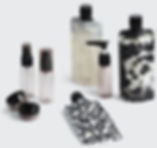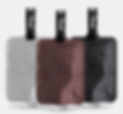5 Simple Solutions: How to love packing
- Jennifer Anvari
- Sep 16, 2025
- 8 min read

The best thing I ever did for my restless, wandering self is learn how to travel with one carry-on bag. You won't believe the difference it makes when you arrive at the airport, unconcerned with the check-in counter and its interminable line, and then breeze out the door at your destination, unbothered by whatever chaos is happening at baggage claim.
The benefit of one-bag travel isn't limited to your flight--it also creates peace of mind throughout your trip. Every time I've chosen to overpack and bring a larger bag, I've come to regret it when my hotel room is crowded by a gigantic suitcase and the myriad items I was sure I needed are cluttering every surface. With so many things, it's almost certain that something vital will be left behind at the end of the trip.
The best part of changing your packing strategy is that it's largely a one-time project. Rather than starting from nothing with each new trip, rootless and overwhelmed by what you might need to bring this time, the one-bag packing strategy means that you put in the forethought and planning one time--from then on, you know precisely what to do, and only need to tweak details by weather or destination as needed.
Here are five travel packing solutions that will ensure you arrive for your next vacation prepared and carefree.

At all costs, underpack
Given the choice between the two, I will choose to underpack rather than overpack every single time. The freedom and flexibility that come from packing light simply cannot be overstated. This requires a change in strategy, yes, but even more than that, I think it requires a change in our mindset toward being prepared. Most overpackers approach a vacation or trip with a certain amount of anxiety: what if X or Y happens, what if something goes wrong, what if we're uncomfortable and it ruins the day?
It's understandable to want to account for every eventuality, but let's be real: an anxious mind is the last thing you want going into a vacation. Instead, I try to cultivate a mindset of flexibility, one that accepts inconvenience as part of the travel experience, and embraces the opportunity for creative problem solving in the moment. Being caught out for a rainy day without an umbrella isn't ideal--but maybe you find a little shop that's selling them, and have an interesting chat with the shopkeeper. Maybe you duck into a store to get out of a downpour and wind up finding a gorgeous coat to buy, one that winds up becoming a wardrobe staple for you for years to come. Maybe, just maybe, you have a cold and wet and grumpy day, but when you finally make it to a restaurant to dry off, you have an amazing conversation while you warm up with your companions. Maybe the tale of your misery is hilarious in hindsight, and you tell the story at parties for the next decade.
Everyone is different: I will take the risk of not packing the umbrella, but there are other niche items I will always bring, because being prepared for that specific eventuality is worth it for me (or the memory of when I wasn't prepared haunts me enough to ensure I don't repeat it!). It's fine to plan and pack for the situations you want to avoid at all costs. I think the problem comes in when we want to be prepared for every eventuality: a goal which is not only imprudent, but is in fact impossible anyway. Embrace the possibility of bad days, trust yourself to be able to creatively solve a problem in the moment, and don't ruin your vacation by trying to force it to be perfect.

Make a standing list
Let's back it up from the suitcase, and start by considering how we live at home. In my house, I store my belongings where I use them: clothes in a dresser, toiletries in the shower or vanity, medications in my nightstand. I think about how I use my things at home, and build out a packing strategy from there: clothes go into a packing cube together, shower toiletries get grouped in a wet/dry bag, grooming products pack in a toiletry bag, and a separate nightstand bag holds a phone charger and my medications. For other categories, I consider where the items will be used on the trip: for example, I have an airplane bag that holds all the things I'll need during the flight, like headphones, earplugs, sanitizing wipes, and my Kindle. Customize the system as needed, but start with the categories, and pack items together by where you'll use them.
Once that's done, take each of these categories and make a standing list of which essential items you will always need. Take the nightstand bag: it requires a wall plug, a charging cable, each individual medication* I will need, and my ever-present emotional support chapstik. In the toiletry bag, note your face wash, sunscreen, lotion, deodorant. For clothing, list the underthings, the shirts, the pants, the shorts, the dresses. List socks and shoes, and a pair of pajamas.
This becomes your standing list. I recommend keeping it digitally: I have mine in Google Keep, set up with nesting items and checkboxes. At the start of planning each trip, I make a duplicate of the list, and begin modifying and customizing it as needed, adding unique things I'll need and deleting things I won't. This almost guarantees I won't forget anything before I leave OR when I'm packing to return home.
*Side note: After a slightly harrowing experience where traveling during the initial days of the Covid pandemic found us locked down under official quarantine/house arrest in Colombia, I always make sure to pack at least one extra week of all prescription medications. You really don't want to be dealing with the collapse of society while you're out of Lorazepam, I promise you.


Get duplicates of everything
If you travel more than once or twice a year, I highly recommend getting duplicates of your toiletries, rather than removing and packing your daily items. This makes the packing process much more streamlined, and means you don't need to unpack everything the second you get home so you can use it the next day. This works really well for makeup: I typically replace my cosmetics a little before they're fully empty, and just transfer the used ones to my makeup bag. This way, all the essentials are good to go.
Similarly, decanting is your friend for most products, and is another way of duplicating what you have. Rather than worrying about buying travel size bottles of products you aren't familiar with and generating a bunch of extra plastic waste, reusable travel bottles are more environmentally friendly, ensure you're using products you know and love, and make topping off your toiletry bag easy. There are tons of options, but I prefer bladder style bottles, which weigh less than nothing empty and allow easy squeezing.

Create a capsule
Capsule wardrobes had a moment a few years ago: the idea was to create a subset of your overall wardrobe, maybe two dozen or so items from your closet that all went together and could be mixed and matched endlessly without much effort or thought. The idea has gone somewhat out of vogue, but it's still extremely useful for a travel wardrobe.
There are lots of ways to go about creating a travel capsule, but I like to start with the shoes, because they're so important: no matter what type of trip you're going on, the shoes are a strategic choice in addition to an aesthetic one. I've spent ages pouring over options, finding the best and most versatile shoes that will allow me to be prepared for anything from an impromptu hiking trail to a sudden downpour to a nice restaurant to 20,000 steps on European cobblestone. For most trips, I limit myself to two pairs--one closed toe, one sandal--maybe three, if the third is beach flip flops or a pair of heels that pack small.
The shoes will be a limiting factor aesthetically, so I start there, and plan my wardrobe around outfits that will coordinate. Next, you'll need to consider the length of your trip to know how many outfits to plan, but I recommend a maximum of about 7 for any length of trip: even being gone for a month at a time, 7 looks is plenty!
To create your capsule, start with something like 2-3 bottoms, 3-5 tops, a dress or two if you like to wear those. Try to ensure most of the tops work with at least two of the bottoms, and all the outfits coordinate with the same accessories. Stick to a limited color palette--if you're uncertain, try black and white with one accent color. Add in functional layers that are appropriate to your destination: a light jacket, a rain coat, a hoodie, etc.
A final note on destination-specific items: pack strategically for beach trips, sticking to the same capsule for bathing suits and cover-ups as needed. For winter trips, I actually recommend packing fewer clothes and more accessories--if you're wearing a coat all day, your photos will look more interesting with a variety of scarves than with a variety of sweaters you can't see. Throw all this fashion-y advice out the window if you're camping.

Make lists of lists of lists
You can never have too many lists. Your standing master packing list is gold, but it isn't the only one you'll need, so make addendum lists, as well. Make a list for winter trips: coats, hats, gloves. Make a list for water-based trips: bathing suits, cover ups, more sunscreen. Make a list for trips where you'll need to dress up, and it's worth it to pack the curling iron. Make another for slow, low key trips where you'll need to bring the puzzles and the board games and the deck of cards.
What types of trips do you go on most often? Make lists for your gear. Do you go skiing, or snowboarding? List your poles and your boots and your goggles. Do you go to the beach? List the umbrella, the chairs, the skim boards, the sand castle supplies. Make a standing list for the cooler, so you don't have to think about it every morning: list your Goldfish crackers or your baby carrots or the sandwiches you'll make and bring. List the water and juice, or the booze you'll sneak in. List the coozies.
Do you rent a vacation house with friends or family? Make a standing grocery list, so you don't need to think about what to get after you've been driving for hours. List easy meals to make for your first day or two, so you don't need to rush to the store. Make a list of things to snag on the way into town--maybe some frozen pizzas for the first night, and coffee for the next morning. If you're going to be cooking dinners, make a list of your easy, crowd pleasing meals, and the groceries you'll need to cook them.
Make a list while you're there, too, about what you brought: what's working well? What would you change next time? Did your makeup melt in the heat, or did you wish you had brought another layer because you froze in the air conditioning? Did you bring too many shorts and not enough pants? Did you wish you'd brought earplugs after the street noise at your hotel kept you up, or did you find you didn't need a purse on a cold weather trip because your coat pockets were good enough? List your packing edits and tweak your master list for next time.
Every list you write in advance saves you literally endless frustration and energy on your trip. Write these lists, keep them handy in your notes app, pull them out when you're in a pinch. Thank past-you for saving travel weary, exhausted, present-you from having to come up with a plan from scratch.
